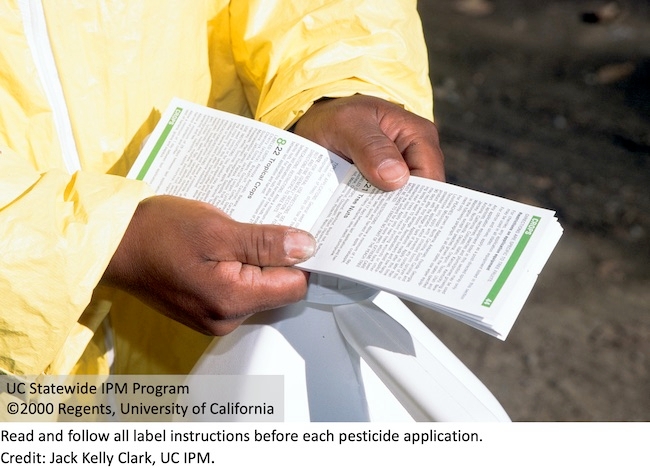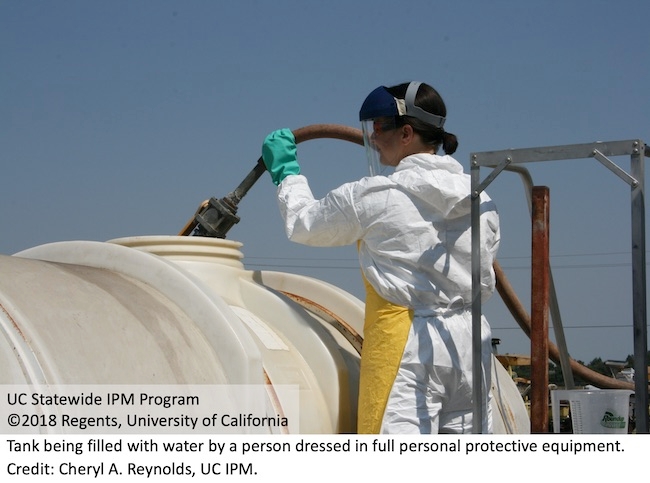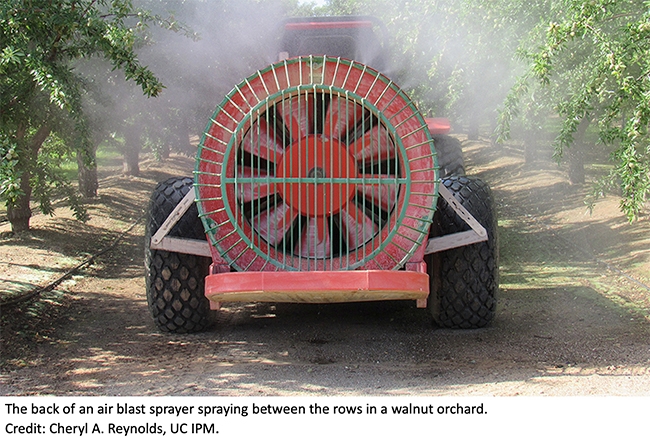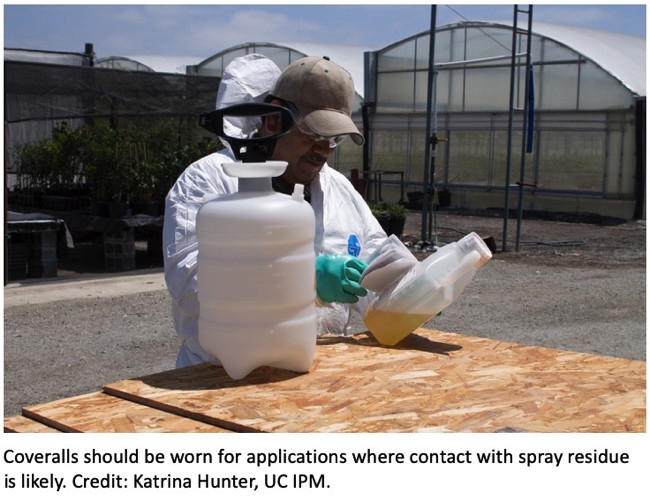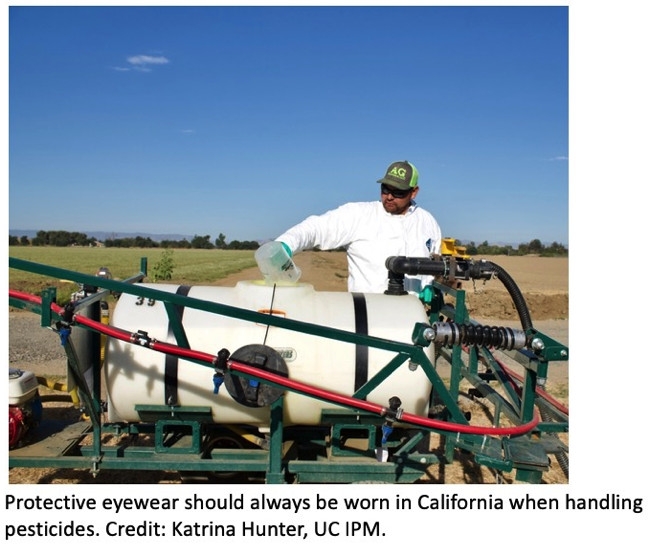- (Public Value) UCANR: Promoting healthy people and communities
- Author: Petr Kosina
To raise awareness of pesticide safety practices, February is celebrated as National Safety Education Month. This year the University of California Statewide Integrated Pest Management Program offers help to refresh your knowledge about safe and effective pesticide use. Two frequently sought-after online courses focused on proper pesticide use to avoid illegal residues and proper selection, use, and removal of personal protective equipment are offered for free during the month of February. Use code safety100 at checkout to get your continuing education units (CEU) for free.
Pesticides are among the most regulated chemicals in the country. In the United States, the Environmental Protection Agency (EPA) regulates the use of pesticides. All pesticides must be registered with the EPA, and the agency requires a battery of scientific tests to determine the potential risk to humans and the environment.
Best practices for using pesticides safely start with reading the label before each pesticide application. How will reading the label help you? Pesticide labels answer most of the basic questions you need to know about the product, its safe application and handling. Always make applications in strict accordance with all label instructions. Following label instructions will ensure safe, effective, and cost-effective use of the pesticide. Apart from the label, it is important to know what your state regulations are because some state regulations that also have to be observed are not written into the label. Note that not all pesticides approved by the EPA and available for purchase in the United States can be used in California. California is one of the few states that have more strict pesticide regulations for certain pesticides than what is required by the EPA. Even if you have used a given pesticide in the past, make sure you have an up-to-date label, as EPA may occasionally change labels. To learn more about pesticide labels and how to extract information relevant to the specific setting and situation in order to apply pesticides safely, enroll in the online course Proper Pesticide Use to Avoid Illegal Residues. Pest management professionals will earn 2.0 hours of Laws & Regs CEUs.
Because pesticides have the potential to cause injury or illness to anyone working with them, it is important to wear personal protective equipment, or PPE, to reduce a person's exposure to pesticides. PPE includes clothing and certain devices worn to protect the human body from contact with pesticides or pesticide residues. Regular clothing is not considered PPE even though some pesticide labels may indicate that these specific items of regular work clothes can be worn during certain activities. All employees who handle pesticides in California are legally required to wear PPE. They must follow all PPE instructions on the pesticide label and follow all California laws and regulations. To learn how to select the proper PPE, use it, remove it, and dispose of it or clean and store it before, during, and after each incidence of pesticide handling and application, enroll in the online course Proper Selection, Use, and Removal of Personal Protective Equipment (PPE). Pest management professionals will earn 1.5 hours of Laws &RegsCEUs.
Visit the UC IPM website to see all 22 online courses that are available for continuing education credit.
We're excited to announce that a brand-new online course on air blast spray calibration is now available. This course was developed by Lynn Wunderlich, University of California Cooperative Extension (UCCE) farm advisor for the Central Sierra, and Franz Niederholzer, UCCE farm advisor for Colusa, Sutter, and Yuba counties. Are you a grower, pest control adviser, or pesticide applicator working in trees and vines? Then this course is for you! You will learn the basic principles of spray calibration, take a close look at the basic components of a sprayer, perform calculations needed for calibration, and take a look at how factors such as droplet size, nozzle type, and weather conditions influence drift and spray coverage. This course also explains the conditions for pesticide applications under the 2018 Pesticide Use Near Schoolsites regulation. Air Blast Spray Calibration has been approved by DPR for a total of 2.5 continuing education units (CEUs), including 0.5 hour of Pesticide Laws and Regulations and 2.0 hours of Other.
As fall approaches and 2020 winds down, it's time to complete your continuing education units and submit your California Department of Pesticide Regulation (DPR) renewal packet. If you are a DPR license or certificate holder and your last name begins with the letters A through L, then 2020 is your year to renew. Renewing now guarantees a quick turnaround time and having enough time to resolve any problems before your license expires. DPR encourages all license holders to send in renewals November 1 to ensure license renewal by January 1, 2021. Why not check out what online courses the UC Statewide IPM Program (UC IPM) has to offer.
Four of UC IPM's most-wanted courses are offered at an early-bird price until November 1st! You can save an additional $20 by purchasing the 4-course bundle for only $85 rather than each course individually.
- Proper Pesticide Use to Avoid Illegal Residues (2 hours Laws and Regulations – early-bird price $40; full price $80)
- Proper Selection, Use, and Removal of Personal Protective Equipment (1.5 hours Laws and Regulations – early-bird price $30; full price $60)
- Pesticide Resistance (2 hours Other – early-bird price $20; full price $40)
- Pesticide Application Equipment and Calibration (1.5 hours Other – early-bird price $15; full price $30)
Many of our courses are now credited not only by DPR for continuing education hours, and also by the California Structural Pest Control Board (SPCB), Certified Crop Advisor (CCA), the Western Chapter of the International Society of Arboriculture (WCISA), and the Arizona Department of Agriculture.
- Author: Lisa A Blecker
- Author: Whitney Brim-DeForest
- Author: A. Katrina Hunter
- Author: Pamela Kan-Rice
While most Californians are staying home to slow the spread of the novel coronavirus, California farmers, farmworkers and other agricultural professionals are out in the fields and packing houses working to produce food.
With increased demand for personal protective equipment, or PPE, to protect against COVID-19, these essential workers are facing shortages. Agricultural commissioners in 28 counties are hearing from farmers who are having trouble getting PPE for their employees and farmers in another 11 counties who are worried about running out of PPE in the next month or two according to a California Department of Pesticide Regulation survey.
Gloves, N95 respirators, coveralls and other gear that workers wear to protect themselves from COVID-19, pesticides, dust and other health hazards are in short supply as priority is given to health care workers during the pandemic.
To reduce the spread of COVID-19, workers may wear homemade face coverings, but for applying pesticides, they must wear respirators specified on the pesticide product label, said Whitney Brim-DeForest, UC Cooperative Extension rice advisor.
Pesticide applicators may use gear that is more protective than required by the product label and regulations.
“Although this could change in the days ahead, half-mask and full-mask respirators are more available than disposable N95 respirators for now,” said Lisa Blecker, coordinator for the UC Pesticide Safety Education Program.
Before the pandemic, 10% of N95 respirators from 3M went to health care, but that number is now 90%, the company said in a letter to distributors. This has led to significant backorders of PPE supplies for distributors.
Carl Atwell, president of Gempler's, an online distributor of worker supplies, said that before the crisis, normal lead times for PPE was up to 10 days. He estimated disposable respirators will become available in the fall and other PPE supplies in August.
In the meantime, there is alternative PPE that agricultural professionals can use during the shortage.
Atwell suggests looking for lesser known brands of PPE as opposed to the first tier of choice: “It's sort of like searching for Purell hand sanitizer. Purell brand might be out of stock, but can you find a different disinfectant?”
On Gempler's website, the more recognizable Tyvek coverall from Dupont is sold out, however disposable protective clothing is available from other brands. Reusable chemical-resistant clothing is also available as opposed to their disposable counterparts. Supplies in high demand are reusable and disposable nitrile gloves, protective clothing, disposable respirators and certain protective eyewear, such as goggles and face shields.
For workers who will be applying pesticides, Blecker and Brim-DeForest offered some guidelines on how to meet PPE requirements as the shortage continues.
General PPE requirements: “Remember, the label is the law,” said Brim-DeForest. “PPE requirements for agriculture are not being loosened.” The UCCE advisor recommends purchasing only what you need for the season and choosing reusable PPE whenever possible. Growers who have excess supplies of PPE can coordinate with their county agricultural commissioner or UCCE advisor to help other producers in their area.
Respirators: If you can't find the respirator required on the label, Blecker said, “Use an alternative, more-protective respirator. For example, if an N95 is required, you can use a half-mask with N95 particulate filters; these can be stand-alone filters or ones that attach to an organic vapor cartridge. You could also use a different pesticide that doesn't require a respirator. Consult with your PCA (pest control adviser) for options.”
Gloves: Chemical-resistant gloves, usually 14 mil or more in thickness are required for most California pesticide applications and should be worn by mixers, handlers and applicators. If nitrile gloves are not available, viton and laminate gloves are universal chemical-resistant materials for most pesticide labels. If the glove material is specified on the label, that instruction must be followed.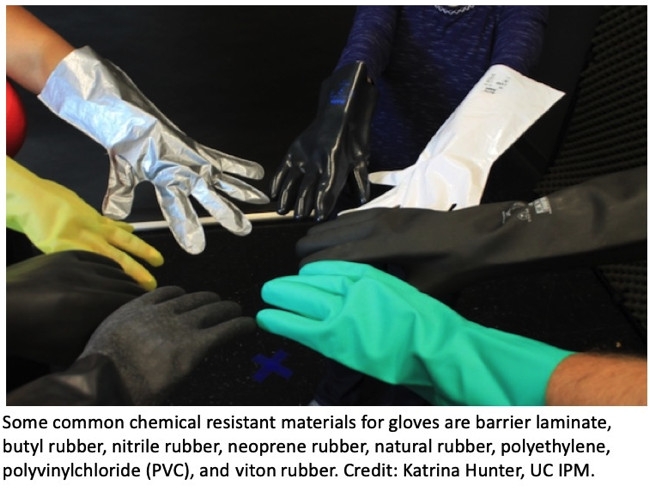
“Disposable gloves less than 14 mil can be worn, but not for more than 15 minutes at a time,” Blecker said. “Farmers should also note that thinner gloves cannot be layered on top of one another.”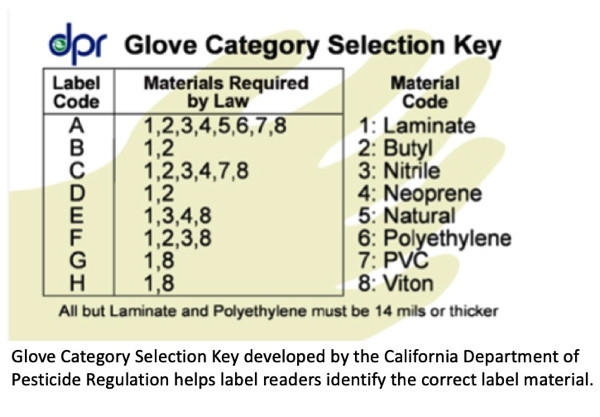
Coveralls: Coveralls should be worn when required by the pesticide label or when the signal word is “WARNING” or “DANGER,” or when applying by backpack or airblast. “Coveralls can be made out of high-density polyethylene fibers (Tyvek and other brands), which are disposable, or cotton, which are reusable,” Brim-DeForest said. “If reusable coveralls are worn, the employer must ensure employees are provided clean coveralls.”
Goggles/face shields: Face shields are required for mixing and loading pesticides only if it's stated on the label. “If a face shield is unavailable, a full-face respirator can be used,” Blecker said. “Goggles or protective eyewear should always be worn in California when handling pesticides, regardless of what the label says. The face shield, goggles or safety glasses must provide front, side and brow protection and meet the American National Standards Institute Z87.1 standard for impact resistance.
For more information about PPE, contact your county agricultural commissioner or see the California Department of Pesticide Regulation's posters at https://www.cdpr.ca.gov/docs/whs/pdf/gloves_for_pesticide_handling.pdf and https://www.cdpr.ca.gov/docs/whs/pdf/n95_alternatives_for_pesticide_handling.pdf.
UC IPM also covers these topics in their pesticide safety webinar series at http://ipm.ucanr.edu/IPMPROJECT/workshops.html


